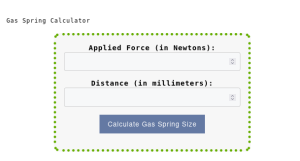Gas Spring Calculator
Gas Spring Calculator
Gas Spring Calculator
A Gas Spring Calculator is a tool used to estimate the required size or force of a gas spring based on the applied force and distance. Gas springs, also known as gas struts or gas shocks, are commonly used in various applications to provide controlled and smooth motion.
Try our Bush Hog Acres per Hour Calculator.
Formula for Gas Spring Size:
The formula used to calculate the required gas spring size is:
Required Gas Spring Size = Applied Force * Distance
Where:
Required Gas Spring Sizerepresents the size or force of the gas spring, typically measured in Newton-millimeters (N·mm).Applied Forcerefers to the force applied to the gas spring, typically measured in Newtons.Distanceis the distance over which the gas spring will operate, typically measured in millimeters.
The formula simply multiplies the applied force by the distance to estimate the required gas spring size. This calculation helps in selecting an appropriate gas spring with the necessary force to support the desired application.
Example:
Let’s consider an example where an applied force of 100 Newtons is acting over a distance of 500 millimeters.
Using the formula:
Required Gas Spring Size = 100 N * 500 mm = 50,000 N·mm
Therefore, based on the given applied force and distance, the estimated required gas spring size is 50,000 Newton-millimeters (N·mm).
FAQs:
- Is the calculated required gas spring size precise? The calculated required gas spring size is an estimation based on the provided inputs and the formula. However, it’s important to note that other factors such as the specific application, mounting orientation, damping requirements, and safety factors may also influence the selection of the appropriate gas spring.
- Can this calculator handle different units of measurement? The formula in the calculator assumes consistent units of measurement, such as Newtons for applied force and millimeters for distance. If you have measurements in different units, you may need to convert them before using the calculator.
- What other factors should be considered when selecting a gas spring? Besides the required force, factors such as the stroke length, desired motion characteristics (e.g., compression, extension, or both), operating temperature, environmental conditions, and safety considerations should also be taken into account when selecting a gas spring. It is advisable to consult the manufacturer’s specifications and guidelines for accurate selection.

